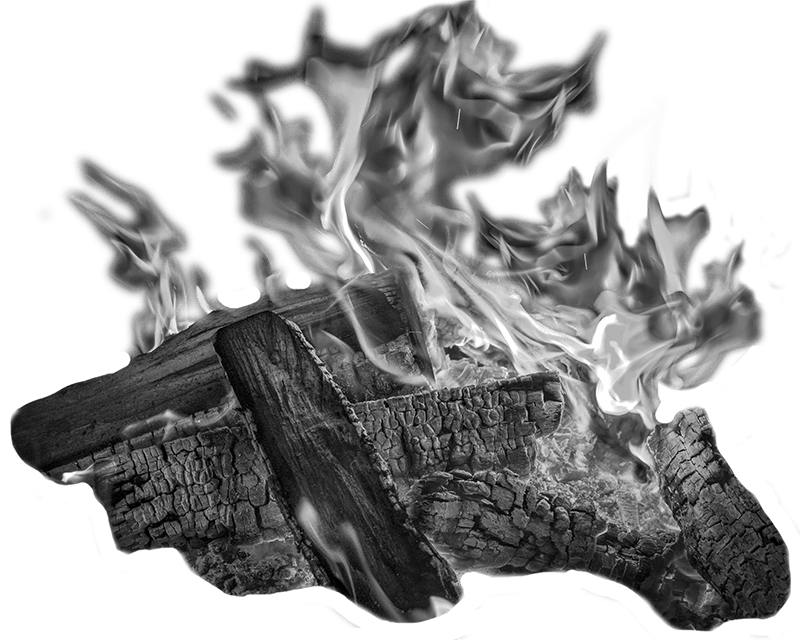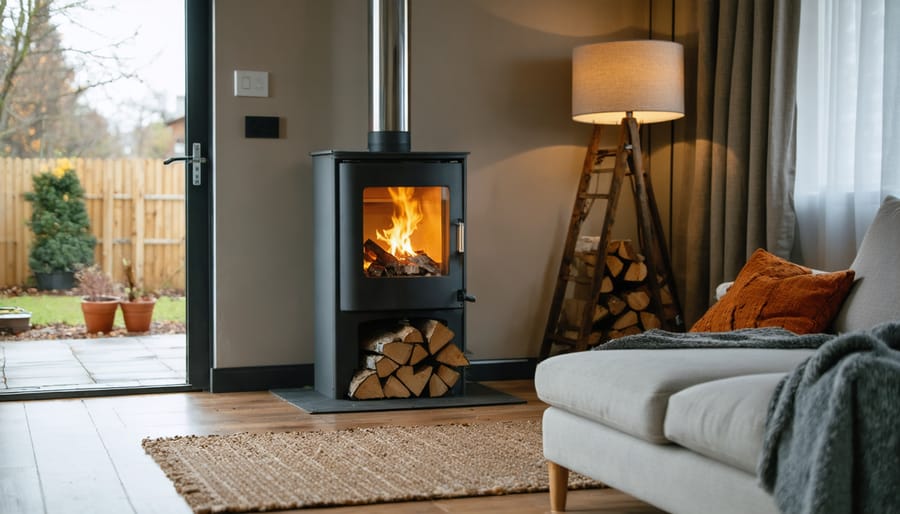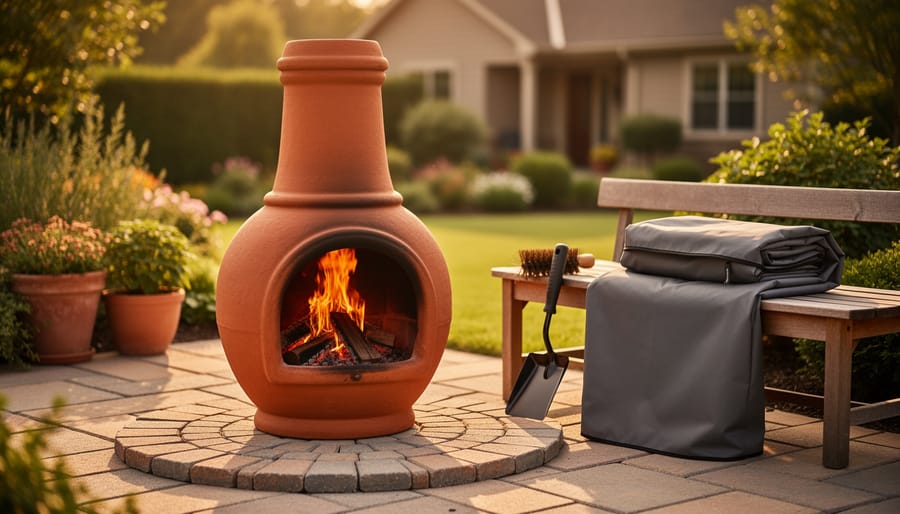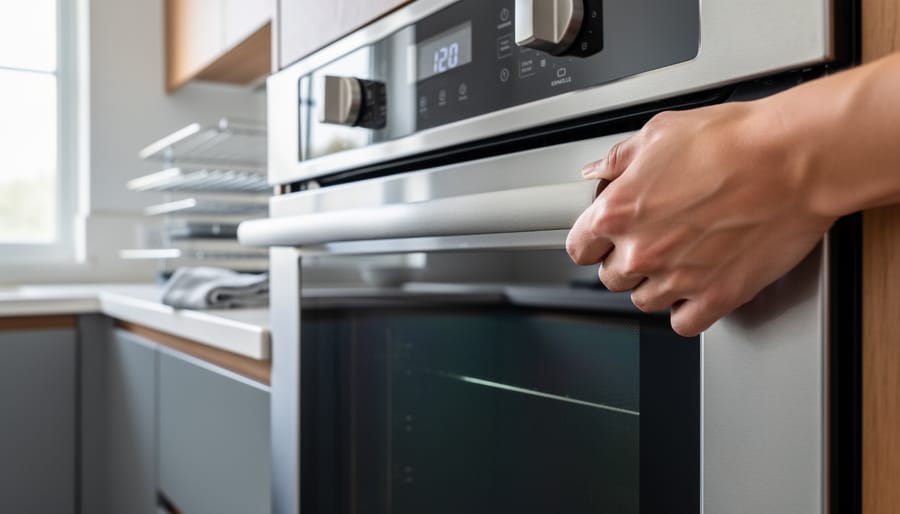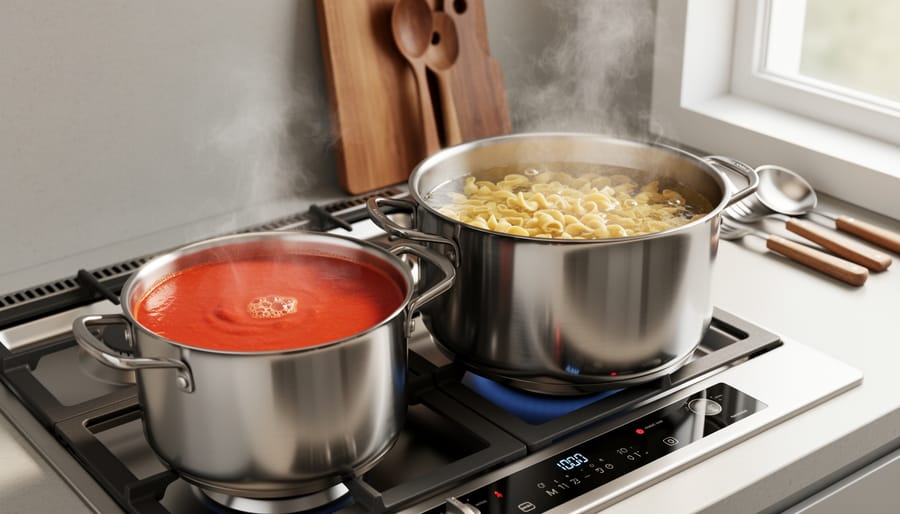Proper wood pellet stove venting stands as the cornerstone of safe, efficient home heating – get it right, and you’ll maximize both safety and performance while minimizing maintenance headaches. Installing a correctly sized vent system with appropriate clearances prevents dangerous exhaust backdraft and ensures optimal burn efficiency, while following proper wood pellet storage guidelines creates a complete safety system for your home. Modern pellet stoves require specific venting configurations that differ significantly from traditional wood stoves, typically needing smaller diameter pipes and more precise installation requirements. Whether you’re upgrading an existing system or installing a new pellet stove, understanding proper venting principles helps protect your investment while keeping your family safe and warm. This comprehensive guide will walk you through essential venting requirements, installation best practices, and critical maintenance steps to ensure your pellet stove operates at peak performance throughout the heating season.
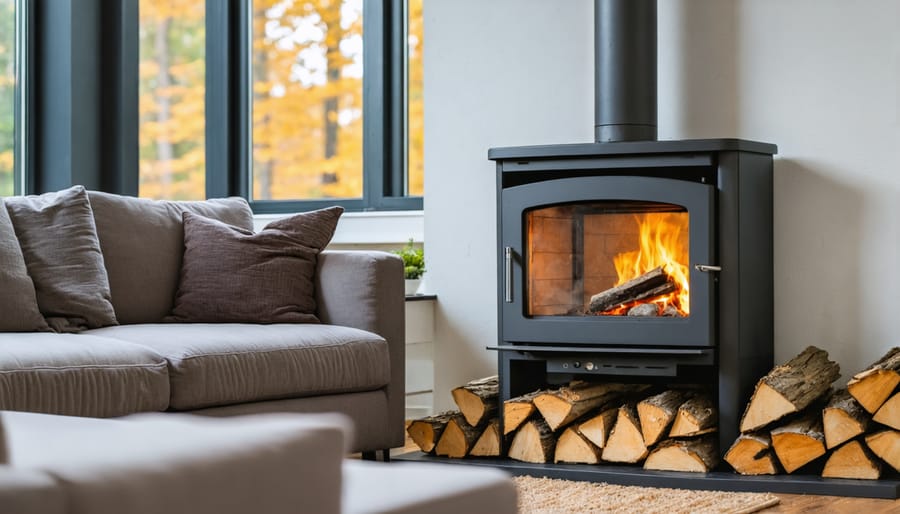
Essential Venting Components for Wood Pellet Stoves
Vent Pipes and Connectors
Pellet stove venting requires specific types of pipes designed to handle the high temperatures and corrosive exhaust gases. The most common type is the L-Vent pipe, made from stainless steel with an aluminum inner core, specifically engineered for pellet stoves. These pipes typically come in 3- or 4-inch diameters, with the size depending on your stove’s manufacturer specifications.
When connecting vent pipes, always ensure each section locks securely with a twist-lock mechanism and is properly sealed at the joints. Double-wall pipes offer superior insulation and safety compared to single-wall alternatives. For vertical runs, you’ll need support brackets every 4-6 feet to maintain stability.
Proper connections are crucial for safety and efficiency. Each joint should be secured with at least three sheet metal screws, and high-temperature silicone should be applied at connection points to prevent exhaust leakage. When passing through walls or ceilings, always use approved thimbles or wall pass-throughs to maintain proper clearance from combustible materials. Remember to follow local building codes and manufacturer guidelines for specific connection requirements in your area.
Through-Wall Components
When installing a pellet stove through an exterior wall, proper through-wall components are essential for safety and efficiency. The wall thimble serves as a critical connection point, creating a safe passage for your vent pipe through combustible wall materials. This specialized fitting includes both interior and exterior plates with proper insulation to maintain required clearances and prevent heat transfer to surrounding materials.
The exterior termination cap is another vital component that protects your venting system from the elements while allowing proper exhaust flow. Choose a cap specifically designed for pellet stoves, as these include features like bird screens and wind protection. The cap should be positioned away from windows, doors, and air intake vents to prevent exhaust from entering your home.
Proper sealing is crucial at all connection points. Use high-temperature silicone sealant around the thimble’s interior and exterior plates, and ensure all joints are thoroughly sealed to prevent exhaust leaks. Regular inspection of these seals helps maintain your system’s efficiency and safety, particularly during seasonal transitions when temperature changes can affect material expansion and contraction.
Proper Venting Configuration for Safe Pellet Storage
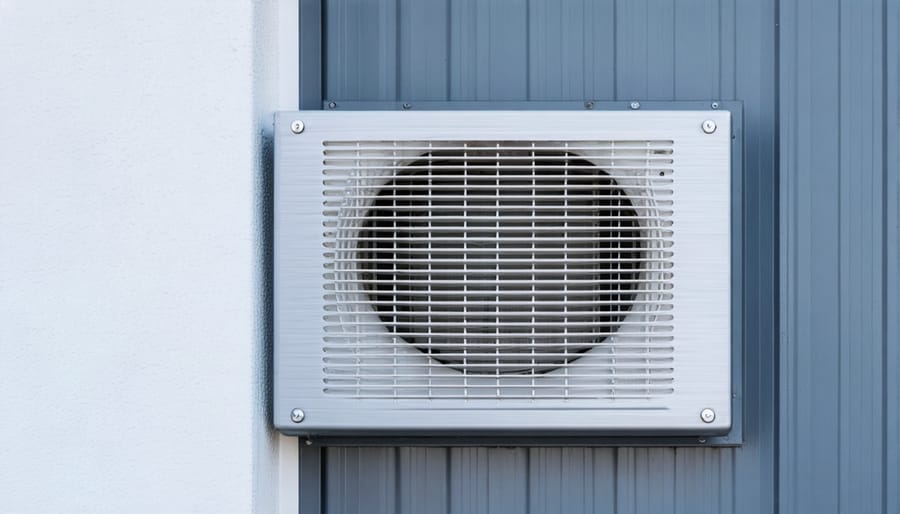
Distance Requirements
Maintaining proper distances between your pellet stove venting system and pellet storage is crucial for both safety and efficiency. When storing wood pellets safely, keep them at least 36 inches away from any venting components, including pipes, connectors, and termination points. This clearance helps prevent potential heat transfer that could compromise the integrity of your stored fuel.
For vertical venting installations, ensure your pellet storage area is positioned away from the entire vent path, including any areas where heat might radiate. A good rule of thumb is to maintain a minimum clearance zone of 48 inches around the complete venting system, especially if you’re storing multiple bags or bulk quantities of pellets.
Horizontal venting requires particular attention, as these configurations often run closer to storage areas. Keep pellets away from wall thimbles and exterior vent terminations, maintaining at least a 48-inch clearance in all directions. This spacing not only protects your fuel supply but also ensures proper airflow around the venting system.
Remember that these distances are minimum requirements, and when possible, it’s better to err on the side of caution by providing additional space. Consider creating a designated storage area that’s well-ventilated and completely separated from your heating system’s components for optimal safety and convenience.
Ventilation in Storage Areas
Proper ventilation in your pellet storage area is crucial for maintaining both the quality of your fuel and the safety of your home. Proper pellet storage ventilation helps prevent moisture buildup, which can cause pellets to break down and become unusable while potentially creating harmful mold growth.
When storing wood pellets, ensure your storage area has adequate air circulation through the use of vents or small fans. For indoor storage spaces like basements or utility rooms, maintain a relative humidity level below 50% to protect your pellets from absorbing moisture from the air. Consider installing a dehumidifier if your storage area tends to be damp.
If you’re using an outdoor storage solution, such as a shed or bin, make sure it’s weather-tight but includes strategically placed vents at both high and low points. This creates natural air movement that helps regulate temperature and humidity levels. Install protective screens over vents to keep out insects and debris while allowing air to flow freely.
Remember that proper ventilation isn’t just about preserving your fuel investment – it’s also a safety consideration. Good air circulation helps prevent the accumulation of wood dust, which can pose both respiratory and fire hazards if left unchecked. Regular inspection of your storage area’s ventilation system ensures your pellets remain in optimal condition for efficient burning.
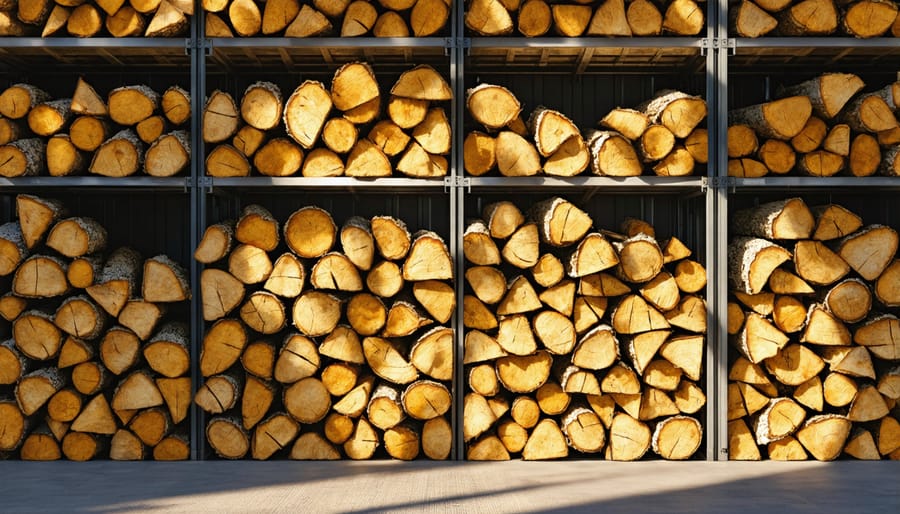
Maintenance and Safety Checks
Cleaning Schedule
Regular cleaning is essential for keeping your wood pellet stove venting system operating safely and efficiently. For optimal performance, inspect and clean your vent pipe at least once a month during the heating season. Begin by checking the exterior vent cap for any debris, birds’ nests, or other obstructions that could impede proper airflow.
Inside, carefully remove and clean the ash trap (if your system has one) every 1-2 weeks, depending on usage. The combustion blower should be cleaned every 2-3 months to prevent ash buildup that could affect its performance. Pay special attention to the vent pipe connections, ensuring they remain properly sealed and free from creosote deposits.
A thorough professional cleaning is recommended at least once per year, typically before the start of the heating season. This should include a complete inspection and cleaning of the entire vent system, from the stove connection to the termination point.
When cleaning, always use appropriate tools like a vacuum designed for ash collection and a vent brush sized specifically for your pipe diameter. Remember to let the system cool completely before beginning any cleaning procedures, and wear appropriate safety gear, including a dust mask and gloves.
Safety Inspections
Regular safety inspections of your pellet stove venting system are crucial for maintaining a safe and efficient heating environment. Start by examining the exterior vent cap for any signs of damage, blockages, or pest intrusion. Check that all vent connections are secure and properly sealed, with no visible gaps or corrosion. While inspecting, follow pellet storage best practices to ensure your fuel isn’t creating excess moisture near the venting system.
Pay special attention to the horizontal sections of your vent pipe, as these areas are more prone to ash and creosote buildup. Use a flashlight to look for any dark, sticky residue or flaky deposits along the pipe walls. Verify that all support brackets are firmly in place and that the required clearances to combustible materials are maintained.
Don’t forget to check the cleaning access points and ensure they’re properly sealed after each inspection. Listen for unusual sounds during stove operation, as these could indicate venting problems. If you notice any concerning issues or aren’t confident in performing these checks yourself, schedule a professional inspection immediately. Regular maintenance not only extends the life of your system but also protects your home and family.
Common Venting Mistakes to Avoid
When installing and maintaining your wood pellet stove venting system, avoiding common mistakes is crucial for both safety and efficiency. One of the most frequent errors is using incorrect pipe diameter. Always match the vent pipe size to your stove manufacturer’s specifications – attempting to modify the size can lead to poor draft and dangerous exhaust buildup.
Another critical mistake is installing horizontal runs without proper rise. Remember, exhaust needs to flow upward, so maintain a minimum 1/4 inch rise per horizontal foot. Some homeowners make the error of having too many elbows or bends in their venting system, which restricts airflow and can cause poor performance or even dangerous backdrafting.
Improper sealing at joints is a common oversight that can lead to exhaust leaks. Every connection should be secured with three screws and sealed with high-temperature silicone when required. Don’t forget to verify that all joints are tight and properly aligned during your regular maintenance checks.
Some people mistakenly use regular stovepipe or B-vent instead of approved pellet vent pipe. This is extremely dangerous – only use venting materials specifically rated for pellet stoves. Similarly, neglecting proper clearance to combustibles is a serious safety hazard that must be avoided.
Regular cleaning is essential, yet many owners underestimate its importance. Failing to clean the venting system regularly can lead to dangerous creosote buildup and reduced efficiency. Create and stick to a maintenance schedule based on your usage patterns.
Lastly, don’t make the mistake of terminating the vent in prohibited locations. Avoid placing vent terminations near doors, windows, air intakes, or areas where exhaust can become trapped. Always consult local building codes and manufacturer guidelines for proper termination requirements to ensure safe operation of your pellet stove system.
Environmental Benefits and Efficiency
Proper venting of your wood pellet stove isn’t just about safety – it’s a crucial factor in maximizing both environmental benefits and heating efficiency. When your stove is correctly vented, it creates optimal conditions for complete fuel combustion, resulting in cleaner burns and fewer emissions. This efficient burning process means you’ll use fewer pellets overall, reducing your carbon footprint while saving money on fuel costs.
The environmental advantages of a well-vented pellet stove are significant. Compared to traditional wood stoves or fireplaces, properly vented pellet stoves produce up to 90% less particulate emissions. This reduction in smoke and pollutants contributes to better air quality both inside and outside your home. Additionally, since wood pellets are typically made from recycled wood waste and sustainable forestry products, proper venting ensures you’re maximizing the eco-friendly potential of this renewable fuel source.
From an efficiency standpoint, correct venting creates the perfect draft conditions that allow your stove to operate at peak performance. This means more heat output from each pellet and less wasted energy. A properly installed venting system helps maintain consistent temperatures throughout your home, reducing the need to supplement with other heating sources. The natural draft created by proper venting also helps remove moisture and combustion gases efficiently, preventing heat loss and ensuring your stove maintains its high efficiency rating.
By keeping your venting system clean and well-maintained, you’ll continue to enjoy these environmental and efficiency benefits while extending the life of your pellet stove. Regular maintenance ensures that your system remains as eco-friendly and efficient as possible, providing sustainable warmth for years to come.
Proper venting is the cornerstone of safe and efficient wood pellet stove operation, playing a crucial role in both performance and pellet storage safety. Throughout this guide, we’ve explored how correct venting installation and maintenance protect your home from dangerous combustion gases while ensuring optimal stove efficiency. Remember that proper ventilation not only safeguards your living space but also helps maintain the quality of stored pellets by preventing moisture buildup and potential degradation.
The relationship between venting and pellet storage cannot be overstated. A well-ventilated system reduces the risk of backdraft, which could potentially affect your stored pellets and create unsafe conditions in your storage area. By following the recommended guidelines for both venting installation and pellet storage, you’re investing in your home’s safety and the longevity of your heating system.
As you embrace the eco-friendly benefits of pellet heating, maintaining proper venting should remain a top priority. Regular inspection and cleaning of your venting system, combined with appropriate storage practices, will ensure your pellet stove continues to provide efficient, sustainable heat for years to come. Don’t hesitate to consult with certified professionals for installation and annual maintenance – the safety and comfort of your home depend on it.
Stay warm, stay safe, and enjoy the sustainable warmth of your properly vented pellet stove system.
